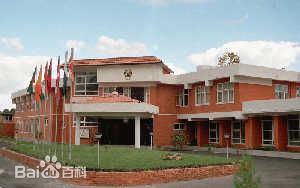Reviving the SAARC
- By Sabena Siddiqui
 0 Comment(s)
0 Comment(s) Print
Print E-mail China.org.cn, September 20, 2017
E-mail China.org.cn, September 20, 2017
 |
|
SAARC secretariat based in Katmandu, Nepal [File photo] |
Reinforcing links between regional countries, the South Asian Association for Regional Cooperation (SAARC) was founded in 1985, with its current membership comprising of Afghanistan, Bangladesh, Bhutan, India, Maldives, Nepal, Pakistan, and Sri Lanka.
With an overall mixed performance, its highest point was in achieving an impressive 7.0 percent average growth rate over two decades. Promoting inter-action and mutual dialogue, SAARC worked for peace and harmony in the region by concentrating on common interests and settling regional issues. Unfortunately, ever since the cancellation of the last SAARC Conference in 2016, a vacuum has been created and the future credibility of the organization is at stake.
Functionally viable, in the past the group put forth different trade structures and mechanisms such as the South Asia Free Trade Agreement and South Asia Preferential Trade Agreement. Lacking any definite roadmap ahead now, it seems to have been postponed indefinitely ever since India refused to participate in the last summit in Islamabad last year.
As yet, no new date is available for the next summit though the SAARC Charter requires that heads of state or government meet once a year, this generally materializes every 18 months. The conference gets postponed if even one of the eight members refuses to participate. Bangladesh, Bhutan and Afghanistan also followed suit as they are close Indian allies. Nepal could not pull out being the current chair of SAARC, it hoped that "a conducive environment be created soon to ensure the participation of all member states in the 19th SAARC summit in line with the spirit of the SAARC charter."
Thus an association for greater regional integration lies ineffective due to non-cooperation. At this juncture, it is time for a gesture like the classic Musharraf -Vajpayee hand-shake at the SAARC Summit in 2002. Proving to be the classic icebreaker of that time, it helped improve Indo-Pak relations.
Addressing the gathering in an ostensibly unplanned move, Musharraf had pointed out how the SAARC association had lost its way, “The way forward is to make SAARC genuinely potent and through it sink differences, resolve disputes on the basis of sovereign equality. Let none amongst us consider themselves more equal than others.” Then taking Indian Prime Minister Vajpayee by surprise, he added, “As I step down from this podium, I extend a genuine and sincere hand of friendship to Prime Minister Vajpayee. Together we must commence the journey for peace, harmony and progress in South Asia.” His gesture forced the Indian PM to rise and shake hands with him, in what many believe was a perfect coup de grace.
Reconciliation between India and Pakistan is the solution towards the success of SAARC, any spat between them has direct bearing on the welfare of South Asia. Perceptibly, the absence of this forum has only increased problems between the two countries while the cancellation of the last summit closed all doors for smaller states in the region to sit together and resolve issues.
Even though SAARC countries ratified and signed the SAARC 1988 Convention of Terrorism and an additional protocol in 2003, these mechanisms have proven inadequate. As of now, there is need for an India-Pakistan detente to prevent further instability in the region and put life into the SAARC body. The future of SAARC remains uncertain and playing the blame-game is not the solution of the problem.
Meanwhile, even as the hostile environment continued, Pakistan floated the idea of extending SAARC and taking in new members such as China, Iran and the Central Asian Republics. Injecting new blood into the organization may be the best solution to breaking the impasse and Pakistan had intended to propose China as the 9th member at the 19th Summit which was cancelled.
Having laid ground for new additions in the organization, Pakistan had already proposed the matter but it was set aside by India. As a senior Indian External Affairs Ministry official said: “They (Pakistan) argue that China can play an important role in persuading Central Asian republics and Iran to join the new arrangement. But SAARC members will have little interest in supporting the idea. There is not much benefit for Bangladesh, Nepal and Sri Lanka in joining a land route far from their borders, and Bangladesh and Sri Lanka have their own ports.”
Even then, extending SAARC remains the best way to revive the presently dysfunctional organization. This possibility needs to be deliberated upon as it would open up more opportunities for everyone concerned. Smaller SAARC states deserve to have the podium back which addressed their grievances. Suitable modification in the structure would improve trade, economic prospects and promote peace in the region.
An organization representing one fifth of humanity surely deserves a second chance and extending membership would further consolidate this geopolitical region and promote connectivity.
Sabena Siddiqui (Twitter: @sabena_siddiqi) is a foreign affairs journalist and lawyer based in Pakistan.
Opinion articles reflect the views of their authors, not necessarily those of China.org.cn.
Follow China.org.cn on Twitter and Facebook to join the conversation.






Go to Forum >>0 Comment(s)